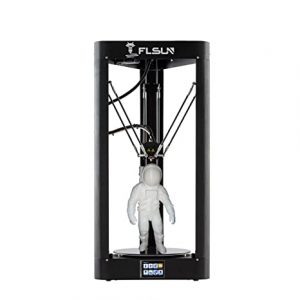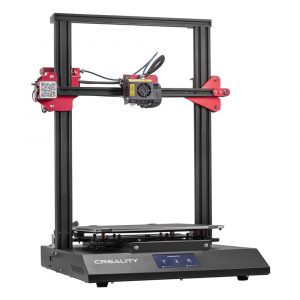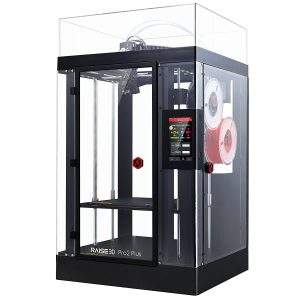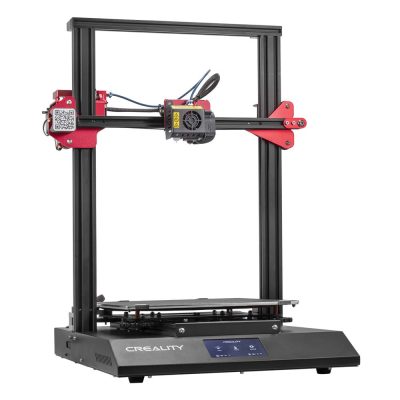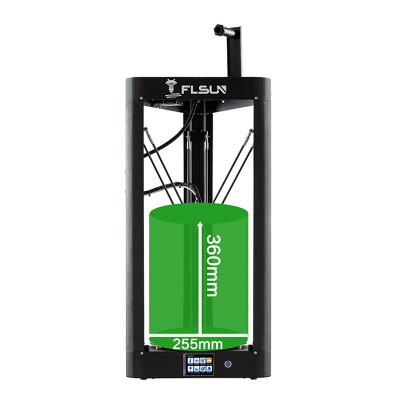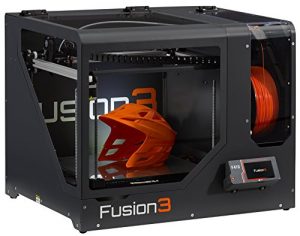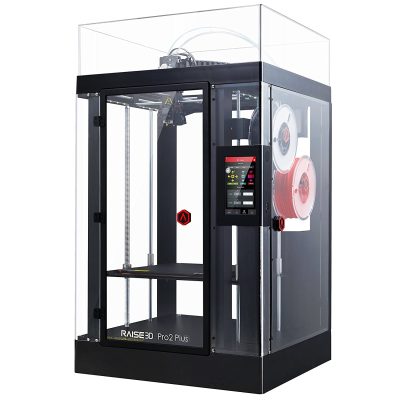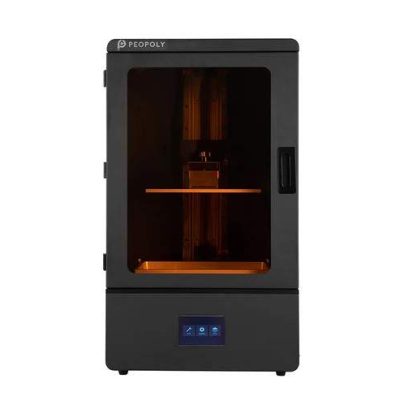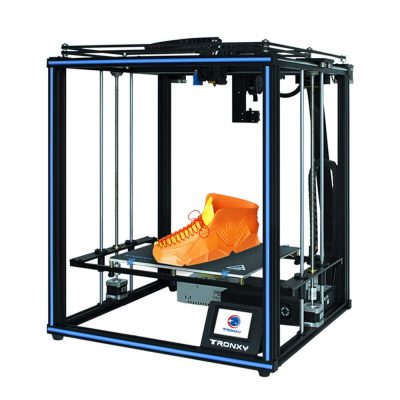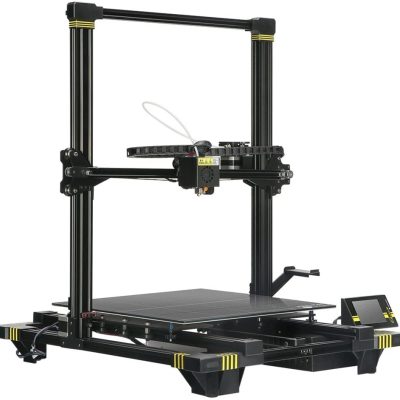- Last Updated: January 12, 2024
 Looking for the Best Large Format 3D Printer on the market for 2024?
Looking for the Best Large Format 3D Printer on the market for 2024?
You’re in luck…
Quoted as the largest 3D printer ever made, UMaine developed a 5,000lb printer capable of 3D printing entire boats!
But that one might fall outside our price range…
Anyway, maybe you’re trying to finally create your replica Master Chief helmet, or the big bad for your D&D campaign, and your current 3D printer just isn’t cutting it.
With a larger machine, the sky’s the limit.
I’m not going to get carried away and start recommending an $80k industrial 3D printer. Still, there’s definitely something to be said for a slightly larger build volume, especially if you have a project that isn’t going to fit in your average 3D printer.
The following list covers some of the best 3D printers on the market, mainly thanks to their larger build volume.
So let’s get going!
Table of Contents
- Top 7 Large 3D Printers At a Glance
- How This List Works
- 1. Creality CR-10S Pro V2 (Best For Beginners)
- 2. FLSUN QQ-S Pro (Fastest Large Format 3D Printer)
- 3. Fusion3 F410 (Best High-End)
- 4. Raise3D Pro 2 Plus (Best Large Format Dual Extruder)
- 5. Peopoly Phenom (Best Large Format Resin 3D Printer)
- 6. Tronxy X5SA (Most Affordable)
- 7. Anycubic Chiron (Best Price for Build Volume)
- What's my top pick?
Top 7 Large 3D Printers At a Glance
How This List Works
I’ve done extensive research in the field, looking for a handful of the best large format printers on the market.
For the sake of this list, “large format” just means it’s a machine with an overall larger build volume than your average desktop 3D printer.
In some cases…
… these 3D printers have only marginally larger build volume, which I’ll consider when I decide on the overall best large format 3D printer.
While researching and testing the printers, I always create a list of pros and cons, figuring out which features and capabilities I liked, and pointing out bugs, design oversights, etc., that reduce the 3D printer’s performance.
Any of these could potentially impact your buying decision the next time you’re looking for the best large objects 3D printer.
Finally, when all is said and done, I’ll be weighing all the pros and cons, large format 3D printing specifications, and personal experience, and I’ll be announcing my pick for the overall best 3D printer in this category.
So there you have it.
Ready to roll?
Let’s do this.
Build Volume: 300 x 300 x 400 mm | Layer Resolution: 0.1 mm | Materials: PLA, ABS, PETG | Maximum Print Speed: 200 mm/s | Printing Software: Cura
As one of the larger names in the industry, Creality gets a lot of brand recognition from experienced creators and 3D printer newbies alike.
The CR-10S Pro V2 is their largest 3D printer, build volume-wise. Initially, its volume isn’t anything too crazy – just 300 x 300 x 400 mm.
But when compared with an average desktop 3D printer – say, the Prusa Original – the difference in build volume becomes a little more clear. The Prusa features a modest 250 x 210 x 210 mm volume, giving the CR-10 a good 30% larger overall build volume.
As for the quality prints themselves…
… the Creality CR gives you the same result you can expect from other Creality 3D printers: its average print speed is pretty quick, and it can max out at 200mm/s, which is excellent for any large 3D printer.
This large format 3D printer has a reasonably solid aluminum frame and some excellent high quality-of-life inclusions – like auto print bed leveling and a material shortage sensor.
It’s a reliable workhorse machine – just with a couple of drawbacks.
Pros
- Excellent typical and max print speeds
- Auto-levelling included
- Fairly intuitive assembly and configuration
Cons
- Print bed sticker isn’t great
- Not the highest print resolution
Build Volume: 260 x 260 x 320 mm | Layer Resolution: 0.05-0.4 mm | Materials: PLA, ABS, HIPS, Wood, PVA | Maximum Print Speed: 300 mm/s | Printing Software: G-Code, OBJ, STL
I looked at this large format printer previously in my “Best Under 500 review”, and frankly, I’m happy to give more positive press to this incredible 3D printer.
As you might guess…
… the FLSUN is an affordable printer, and an excellent one at that.
It’s a specialist at printing tall items – handling projects up to 360 mm tall!
But that’s just the tip of the iceberg with this machine.
The FLSUN QQ-S Pro is a delta-style printer (which has become pretty popular in eastern markets), giving it a cool hourglass-shape that sets it apart from the regular cartesian-style printers.
One of the best things about delta printers is an increased height that benefits their vertical build volume. In addition, this 3D printer has an incredible speed – up to 300 mm/s – putting it as the unlikely contender for our fastest printer on the list.
The printer is a bit loud, but that’s to be expected, considering its blistering speed.
Of course, given the FLSUN’s price range, there aren’t many additional features added to this machine. It does come with automatic bed leveling, which was a pleasant surprise, but that’s about it for quality-of-life features.
But hey, you’re getting a large, superb printer at a great price.
All good.
Pros
- Breakneck max speed
- Excellent vertical height
- Outstanding price point
Cons
- A bit noisy
- Fewer quality-of-life inclusions
Build Volume: 356 x 356 x 316 mm | Layer Resolution: 0.021 mm | Materials: PLA, ABS, HIPS, TPU, PC, Nylon, TPE, FLEX, PETG, Metallic PLA, Wood PLA, Carbon Fiber | Maximum Print Speed: 250 mm/s | Printing Software: Simplify3D
Taking a step up on the price scale, we come to the Fusion3 F410.
I must confess that before writing this article, I knew absolutely nothing about this company, nor any of their 3D printers.
But after doing my research, I think the F410’s one of the best large format 3D printers to be included on the list.
Like I had said initially…
… it’s a large 3D printer with a larger price tag.
But its overall performance and excellent print volume really justify the price bump. Whether you’re able to budget for a large 3D printer like this or not is another question entirely.
The F410 is a fully-enclosed 3D printer – meaning you’ll watch your creations come to life behind a glass box.
This on its own is characteristic of much more expensive machines, as the enclosed environment gives any 3D printer a greater internal environmental control and less temperature-based issues over the long term.
As far as print volume goes…
… this large format 3D printer has some of the best stats for any enclosed machines short of industrial-grade workhorses.
Its volume clocks in at 356 x 356 x 316 mm, which is near the overall average of this list, but much higher than your regular desktop 3D printer, particularly enclosed ones.
Other standout features include:
- an incredible max print speed (250 mm/s: one of the best on the list)
- mobile-based print commands (just use an ethernet with your phone)
- not to mention automated print bed leveling and filament detection.
Of course, you’ll be spying on all of those.
This is an expensive machine – up to 10x the price of others on this list.
But you’re paying for a high-quality 3D printer, and that’s what you’ll get.
Pros
- Excellent typical and max print speeds
- Auto-levelling included
- Fairly intuitive assembly and configuration
Cons
- Very expensive
- Plate glass enclosure occasionally breaks, requiring replacement
Build Volume: 305 x 305 x 605 mm | Layer Resolution: 0.01 mm | Materials: PLA, ABS, HIPS. PC. TPU, TPE, NYLON, PET, ASA, PP, PVA, Glass Fiber Infused, Carbon Fiber Infused, Metal Fill, Wood Fill | Maximum Print Speed: 150mm/s | Printing Software: ideaMaker
Sticking with another expensive and fully-enclosed 3D printer, the Raise3D Pro 2 Plus has a lot in common with the F410.
Like the F410, I didn’t know too much about this large format 3D printer when I started researching and was initially a little leery of including two relatively expensive machines on our list.
However…
… the large build volume and customer reviews looked promising, so I figured I would try this 3D printer out for myself.
Needless to say, I was pretty impressed by the Pro 2 Plus.
Starting with the most important factor (for this list), this 3D printer has a significant build volume – the biggest of any machine so far. Measuring a total of 305 x 305 x 605 mm, you can create some awe-inspiring stuff with it, particularly things that are quite a bit taller than anything coming out of a regular desktop 3D printer.
But what else comes with this increased price tag?
Well, unlike the F410, this large scale 3D printer is a dual extruder, giving you all the options that come with that, rather than being constrained to a single filament type and/ or color.
While the print speed on this 3D printer is a little slower than some of the entries on the list – only 30-150mm/s, that’s still a perfectly reasonable clip.
And the Pro 2 Plus makes up for this with excellent layer resolution (0.01 mm) and one of the most accepting filament catalogs I’ve ever seen.
Seriously…
… you can print with just about any material out there.
Finally…
… you should expect some exciting features for a 3D printer of this price range, and you won’t be disappointed.
The Pro 2 Plus offers pre-calibrated leveling, a live camera, and WiFi connectivity, not to mention all the other benefits of contained printing I mentioned on the F410.
Pros
- Excellent layer resolution
- Live camera and WiFi connectivity
- Large build volume
Cons
- Very (very) expensive
- Not as fast as other printers in its price point
Build Volume: 276 x 155 x 400 mm | Layer Resolution: 0.072 mm | Materials: Resin | Maximum Print Speed: N/A | Printing Software: ChituBox
It’s only fair we include a resin printer on this list as an alternative to the solid filaments that continue to dominate the field.
For my part…
… I was curious to see whether the resin approach would hold up for heftier build volumes, as it has shown itself to be a completely viable alternative to other desktop 3D printers.
So how was it?
The first thing I noticed about the Phenom was its substantial construction.
Like the last two printers, the Phenom is completely encased and square. However, where the F410 was mostly made out of (relatively) fragile plate glass, the Phenom has an aura of invincibility, reinforced by its all-metal chassis.
Unfortunately, the front glass panel is noted as a “consumable” on the Peopoly website, which gives the plate a 400-hour average lifespan.
Given that resin 3D printers tend to take longer than solid filaments, this could mean an oft-repeated expense.
Beyond that…
… this large printer has a decent build volume at 276 x 155 x 400 mm, though that’s nothing revolutionary, particularly on this list.
What I did like about this 3D printer was its incredibly responsive UI.
Like most printers, this is accomplished via a touch screen.
Unlike most printers, it doesn’t involve repeated issues and frustrations.
Instead, it tells you the expected print time (and is relatively accurate in doing so) as well as other important information and warnings.
Bed leveling was also a cinch.
Finally…
… the standout feature to me was its excellent print quality and resolution. While some printers on this list manage a better print resolution (the F410 and the Pro 2 Plus), this is some of the very best resolution you’ll find in a large printer at this price point.
Pros
- Bed leveling - ease of use
- Excellent touchscreen controls and feedback
- Very impressive print quality
Cons
- Smaller build volume
- Regular front panel replacement required
Build Volume: 330 x 330 x 400 mm | Layer Resolution: 0.1 mm | Materials: PLA, TPU, ABS, Wood, PC, HIPS | Maximum Print Speed: 100 mm/s | Printing Software: Tronxy Slicing Software
After our extended departure to the land of expensive 3D printers, I’m back with another very affordable addition to the list: the Tronxy X5SA.
The X5SA has an awful lot going for it – the first of which is its sizable build volume.
Compared to our other affordable 3D printers on this list – the Creality – the build volume between these two printers is relatively comparable.
However…
… the Tronxy does edge the Creality out and costs less as well!
But given its lower price point, this printer won’t spoil you with all the previous printers’ nifty add-ons.
You won’t have any mobile connection or high-tech filament detectors, or any similar cushy add-ons.
Rather…
… this machine is a solid, large, high-volume 3D printer with excellent build space, solid speed, and some interesting quirks.
As far as build speed is concerned…
… the Tronxy does lag behind the other 3D printers on this list (maxes out at 100 mm/s). It does make up for this by efficiently handling a wide range of filaments (PLA, TPU, ABS, PC, HIPS, wooden filament, etc.).
The Tronxy is also a fairly solid build, reinforced where it matters, and capable of taking some punishment before anything goes wrong.
In reviews that focus on large, high-priced printers, this is an oft-overlooked factor, so I want to give credit where it’s due.
Finally…
… it’s only fair I mention some of the, uh, quirks of this 3D printer.
To start, it’s got some weird patent slicer software.
And while the printer is listed as compatible with popular software like Cura and Repetier-Host, I didn’t find this to be the case.
The printer also requires some reasonably extensive assembly, and this isn’t the easiest thing in the world. As you’re assembling this 3D printer, you’ll get the sense that you’re building Frankenstein’s monster, with varying Philips and standard screws, an extra wheel on the guide trail, etc.
Pros
- Sturdy construction
- Excellent price point
Cons
- Slow build speed
- Many small quirks
Build Volume: 400 x 400 x 450 mm | Layer Resolution: 0.05-0.3 mm | Materials: PLA, ABS, HIPS, PETG, Wood, TPU | Maximum Print Speed: 100 mm/s | Printing Software: Cura
Last but not least, the Chiron is larger than most of Anycubic’s other 3D printers, coming in with a hefty 400 x 400 x 450 mm build volume.
Though it’s not the largest of any printer on the list, it’s undoubtedly huge for printers at this price point.
As for its other specs…
… the Chiron has about average print speed – a little low for this list at 20-100 mm/s – and a wide range for print resolution, ending up somewhere between 0.05 mm and 0.3 mm.
The best part of the Chiron…
… is its consistency.
I never ran into any persistent issues throughout my trials, and I got the impression that this large printer can take some punishment before it falters.
This 3D printer also comes with some convenient quality-of-life upgrades, including a resume-print function, some (janky) auto-leveling, and a missing-filament alarm.
Pros
- Excellent build volume
- Sturdy construction
- Good quality-of-life inclusions
Cons
- Slow print speed
- Lacking in print resolution
What's my top pick?
So there you have it – an exhaustive list of the very best large format 3D printers in the world.
If you’ve made it this far, I guess you want to know my pick for the best of them all?
My Pick: FLSUN QQ-S
You just can’t beat the value of this printer, from its incredible max build speed, to its great vertical build options, to the overall care that the manufacturers have put into its design, to its ridiculous price.
I’d like to focus on the last point first: this is the most affordable 3D printer on this list.
It’s also the fastest 3D printer on this list, and it’s capable of creating some super high-resolution quality prints.
In other words…
… it performs everywhere you need it to.
The only significant downsides to this 3D printer are its loudness – which has been improved since previous versions, its incompatibility with US power outlets, and its lack of quality-of-life features.
All of these are more inconveniences than deal-breakers, and none really impacted my experience with this excellent 3D printer.
So there you have it!
Thank you so much for reading. Whether you decide to go with the FLSUN or some other 3D printer on this list, I wish you many happy 3D printing experiences.
Now – build something super cool!



